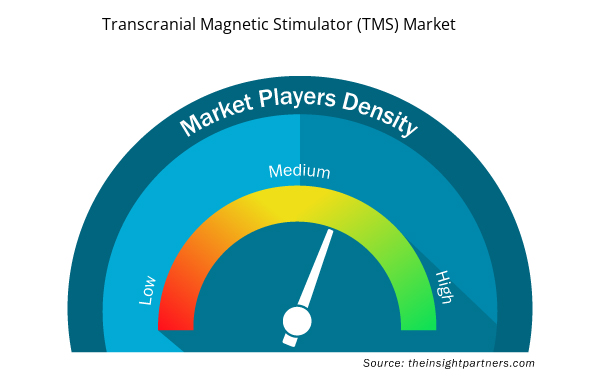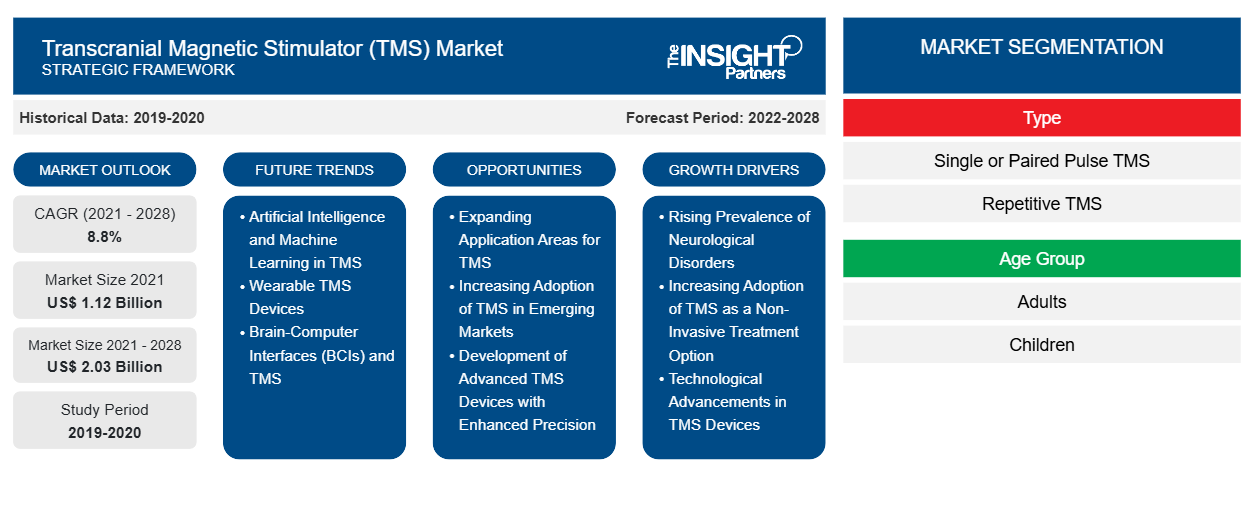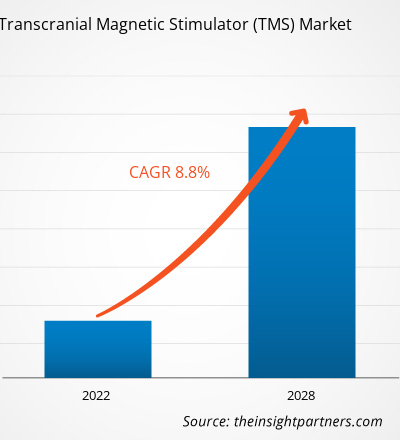[Rapporto di ricerca] Si prevede che il mercato degli stimolatori magnetici transcranici ( TMS ) raggiungerà i 2.029,71 milioni di dollari entro il 2028, rispetto ai 1.122,22 milioni di dollari del 2021; si prevede che registrerà un CAGR dell'8,8% dal 2021 al 2028.
I disturbi neurologici colpiscono il cervello e i nervi del corpo umano e causano epilessia e convulsioni, morbo di Parkinson, demenza, autismo, morbo di Alzheimer, tumori cerebrali e paralisi cerebrale, tra gli altri. La prevalenza dei disturbi neurologici è in aumento in tutto il mondo. Secondo il Global Burden of Disease Study ( GBD ) 2017, il morbo di Alzheimer e altre demenze [2,55 milioni di anni di vita aggiustati per disabilità ( DALY )], l'ictus [circa 3,58 milioni di DALY ] e l'emicrania (circa 2,40 milioni di DALY ) sono state le tre malattie neurologiche più gravose negli Stati Uniti in termini di numero totale di anni di vita aggiustati per disabilità.
Inoltre, l'Alzheimer's Association stima che oltre 6 milioni di americani siano affetti dal morbo di Alzheimer e si prevede che il numero raggiungerà quasi 13 milioni entro il 2050. Lo stimolatore magnetico transcranico ( TMS ) è ampiamente utilizzato per la diagnosi e il trattamento dei disturbi neurologici. Ad esempio, secondo BrainsWay Ltd., nell'aprile 2021, 100.000 pazienti in tutto il mondo sono stati trattati con il suo Deep TMS . Pertanto, la crescente prevalenza di disturbi neurologici guida la crescita del mercato dello stimolatore magnetico transcranico ( TMS ) a livello globale. Inoltre, la depressione è uno dei disturbi mentali osservati comunemente tra le persone in tutto il mondo. Secondo i dati pubblicati dall'OMS nel gennaio 2020, oltre 264 milioni di persone di tutte le età soffrono di depressione in tutto il mondo.
Personalizza questo report in base alle tue esigenze
Riceverai la personalizzazione gratuita di qualsiasi report, comprese parti di questo report, o analisi a livello nazionale, pacchetto dati Excel, oltre a usufruire di grandi offerte e sconti per start-up e università
- Scopri le principali tendenze di mercato in questo rapporto.Questo campione GRATUITO includerà analisi di dati che spaziano dalle tendenze di mercato alle stime e alle previsioni.
Approfondimenti di mercato
La stimolazione magnetica transcranica ( TMS ) è una procedura non invasiva che aiuta a trattare i disturbi neurologici. Inoltre, i crescenti sviluppi tecnologici nella TMS ne hanno aumentato le applicazioni. Le aziende che operano nel mercato degli stimolatori magnetici transcranici ( TMS ) stanno adottando varie strategie, come l'ottenimento delle approvazioni della Food and Drug Administration (FDA) per i loro prodotti innovativi, partnership commerciali e raccolta di fondi per lo sviluppo dei prodotti, che promuovono la crescita del mercato.
Di seguito alcuni esempi di sviluppi:
- Nel marzo 2021, MagVenture ha introdotto MagVenture Flow Arm, un sistema di posizionamento clinico in attesa di brevetto, progettato per ottimizzare l'erogazione dei protocolli di MagVenture approvati dalla FDA per la tecnologia di stimolazione cerebrale non invasiva per il trattamento del disturbo depressivo maggiore e come terapia aggiuntiva per il disturbo ossessivo compulsivo (DOC).
- Ad agosto 2020, MagVenture TMS Therapy ha ricevuto l'autorizzazione della FDA per il trattamento aggiuntivo del DOC. È la seconda indicazione negli Stati Uniti per l'azienda danese di dispositivi medici MagVenture.
- A febbraio 2019, eNeura, Inc., una società privata di tecnologia medica, ha annunciato una nuova autorizzazione 510(k) dalla FDA. Con l'autorizzazione, la società ha affermato che sTMS è l'unico prodotto per l'emicrania negli Stati Uniti per il trattamento di emicranie acute e profilattiche negli adulti e nei bambini (12 anni e oltre).
Pertanto, si prevede che il coinvolgimento attivo degli attori globali nello sviluppo della stimolazione magnetica transcranica e delle tecnologie correlate sosterrà la crescita del mercato.
Informazioni basate sul tipo
In base al tipo, il mercato degli stimolatori magnetici transcranici (TMS) è segmentato in TMS a impulsi singoli o accoppiati e TMS ripetitiva (rTMS). Nel 2021, il segmento TMS a impulsi singoli o accoppiati deteneva una quota maggiore del mercato. Tuttavia, si prevede che il segmento TMS ripetitiva (rTMS) registrerà un CAGR più elevato nel periodo 2021-2028.
Approfondimenti basati sulle applicazioni
In base all'applicazione, il mercato è segmentato in ricerca, diagnostica e terapeutica. Nel 2021, il segmento diagnostico ha detenuto la quota maggiore del mercato e si prevede che crescerà al CAGR più elevato nei prossimi anni.
Le aziende che operano nel mercato degli stimolatori magnetici transcranici (TMS) sottolineano l'importanza di adottare la strategia di innovazioni di prodotto per soddisfare le mutevoli esigenze dei clienti in tutto il mondo, il che consente loro anche di mantenere il proprio marchio nel mercato globale.
Ambito del rapporto di mercato sullo stimolatore magnetico transcranico
Approfondimenti regionali sul mercato degli stimolatori magnetici transcranici (TMS)
Le tendenze regionali e i fattori che influenzano il mercato degli stimolatori magnetici transcranici (TMS) durante il periodo di previsione sono stati ampiamente spiegati dagli analisti di Insight Partners. Questa sezione discute anche i segmenti di mercato degli stimolatori magnetici transcranici (TMS) e la geografia in Nord America, Europa, Asia Pacifico, Medio Oriente e Africa e America meridionale e centrale.

- Ottieni i dati specifici regionali per il mercato degli stimolatori magnetici transcranici (TMS)
Ambito del rapporto di mercato sullo stimolatore magnetico transcranico (TMS)
| Attributo del report | Dettagli |
|---|---|
| Dimensioni del mercato nel 2021 | 1,12 miliardi di dollari USA |
| Dimensioni del mercato entro il 2028 | 2,03 miliardi di dollari USA |
| CAGR globale (2021 - 2028) | 8,8% |
| Dati storici | 2019-2020 |
| Periodo di previsione | 2022-2028 |
| Segmenti coperti | Per tipo
|
| Regioni e Paesi coperti | America del Nord
|
| Leader di mercato e profili aziendali chiave |
|
Densità degli attori del mercato: comprendere il suo impatto sulle dinamiche aziendali
Il mercato degli stimolatori magnetici transcranici (TMS) sta crescendo rapidamente, spinto dalla crescente domanda degli utenti finali dovuta a fattori quali l'evoluzione delle preferenze dei consumatori, i progressi tecnologici e una maggiore consapevolezza dei benefici del prodotto. Con l'aumento della domanda, le aziende stanno ampliando le loro offerte, innovando per soddisfare le esigenze dei consumatori e capitalizzando sulle tendenze emergenti, il che alimenta ulteriormente la crescita del mercato.
La densità degli operatori di mercato si riferisce alla distribuzione di aziende o società che operano in un particolare mercato o settore. Indica quanti concorrenti (operatori di mercato) sono presenti in un dato spazio di mercato in relazione alle sue dimensioni o al valore di mercato totale.
Le principali aziende che operano nel mercato degli stimolatori magnetici transcranici (TMS) sono:
- Azienda
- Prossimo Stim
- Stimolazione magnetica
- Neuronetica
- Soluzioni TMS Neuro
Disclaimer : le aziende elencate sopra non sono classificate secondo un ordine particolare.

- Ottieni una panoramica dei principali attori del mercato degli stimolatori magnetici transcranici (TMS)
Mercato degli stimolatori magnetici transcranici (TMS) – Segmentazione
Per tipo
- TMS a impulsi singoli o accoppiati
- TMS ripetitiva (rTMS)
Per fascia d'età
- Adulti
- Bambini
Per applicazione
- Ricerca
- Diagnostic
- Terapeutico
Per Geografia
- America del Nord
- NOI
- Canada
- Messico
- Europa
- Francia
- Germania
- Italia
- Regno Unito
- Spagna
- Resto d'Europa
- Asia Pacifico (APAC)
- Cina
- India
- Corea del Sud
- Giappone
- Australia
- Resto dell'APAC
- Medio Oriente e Africa (MEA)
- Sudafrica
- Arabia Saudita
- Emirati Arabi Uniti
- Resto del MEA
- America del Sud e Centro (SCAM)
- Brasile
- Argentina
- Resto della TRUFFA
Profili aziendali
- Azienda
- Nexstim, Magstim
- Neuronetica
- Soluzioni TMS Neuro
- MagVenture, Inc.
- eNeura Inc.
- Neurosoft
- MAG & More GmbH
- Analisi storica (2 anni), anno base, previsione (7 anni) con CAGR
- Analisi PEST e SWOT
- Valore/volume delle dimensioni del mercato - Globale, regionale, nazionale
- Industria e panorama competitivo
- Set di dati Excel



Report Coverage
Revenue forecast, Company Analysis, Industry landscape, Growth factors, and Trends

Segment Covered
This text is related
to segments covered.

Regional Scope
North America, Europe, Asia Pacific, Middle East & Africa, South & Central America

Country Scope
This text is related
to country scope.
Domande frequenti
Asia Pacific is expected to be the fastest-growing region and is likely to expand at a high growth rate due to large geriatric population, rising numbers of neurological disorders are among the factors expected to drive the market in the region during the forecast period.
The global Transcranial Magnetic Stimulator (TMS) market based on type is segmented into Single or paired pulse TMS and Repetitive TMS (rTMS). In 2021, the Single or paired pulse TMS segment held the largest share of the market, by type. The Repetitive TMS (rTMS) segment of Transcranial Magnetic Stimulator (TMS) market is also expected to witness fastest CAGR during 2021 to 2028..
The Transcranial Magnetic Stimulator (TMS) market majorly consists of the players such as BrainsWay Ltd, Nexstim, Magstim, Neuronetics, TMS Neuro Solutions, MagVenture, Inc., eNeura Inc., Neurosoft, MAG & More GmbH. REMED among others amongst others.
The US is the largest market for Transcranial Magnetic Stimulator (TMS) at a global level. The US is the largest and fastest-growing market for the TMS market. The market growth is attributed to increasing developments of the medical device sector for neuromodulation, significantly rising incidences of neurological disorders among people and growing demand for neuromodulation devices for chronic pain management. In addition, the economic burden to treat neurological disorders is significantly growing in the country. For instance, according to a study published by the American Neurological Association in March 2017, ~US$ 800 billion is spent per year for treating neurological disorders. The cost of treatment affects ~100 million people every year across the country. It is also estimated that the treatment cost of dementia and stroke alone is estimated to reach over US$ 600 billion in 2030.
The factors that are driving and restraining factors that will affect Transcranial Magnetic Stimulator (TMS) market in the coming years. Factors such as rising prevalence of neurological disorders, growing developments in transcranial magnetic stimulation technology are driving the market growth. However, high cost of diagnostic and treatment are likely to hamper the growth of the market.
Transcranial Magnetic Stimulator (TMS), also referred to us repetitive Transcranial Magnetic Stimulator (rTMS), is a type of brain stimulation in which a changing magnetic field is applied to a specific area of the brain. An electric pulse stimulator is attached to a magnetic coil, which is then connected to the scalp. It is a non-invasive procedure and is used for diagnostic and therapeutic applications.
Trends and growth analysis reports related to Life Sciences : READ MORE..
The List of Companies - Transcranial Magnetic Stimulator (TMS) Market
- BrainsWay Ltd
- Nexstim
- Magstim
- Neuronetics
- TMS Neuro Solutions
- MagVenture, Inc.
- eNeura Inc.
- Neurosoft
- MAG & More GmbH.
- REMED
The Insight Partners performs research in 4 major stages: Data Collection & Secondary Research, Primary Research, Data Analysis and Data Triangulation & Final Review.
- Data Collection and Secondary Research:
As a market research and consulting firm operating from a decade, we have published and advised several client across the globe. First step for any study will start with an assessment of currently available data and insights from existing reports. Further, historical and current market information is collected from Investor Presentations, Annual Reports, SEC Filings, etc., and other information related to company’s performance and market positioning are gathered from Paid Databases (Factiva, Hoovers, and Reuters) and various other publications available in public domain.
Several associations trade associates, technical forums, institutes, societies and organization are accessed to gain technical as well as market related insights through their publications such as research papers, blogs and press releases related to the studies are referred to get cues about the market. Further, white papers, journals, magazines, and other news articles published in last 3 years are scrutinized and analyzed to understand the current market trends.
- Primary Research:
The primarily interview analysis comprise of data obtained from industry participants interview and answers to survey questions gathered by in-house primary team.
For primary research, interviews are conducted with industry experts/CEOs/Marketing Managers/VPs/Subject Matter Experts from both demand and supply side to get a 360-degree view of the market. The primary team conducts several interviews based on the complexity of the markets to understand the various market trends and dynamics which makes research more credible and precise.
A typical research interview fulfils the following functions:
- Provides first-hand information on the market size, market trends, growth trends, competitive landscape, and outlook
- Validates and strengthens in-house secondary research findings
- Develops the analysis team’s expertise and market understanding
Primary research involves email interactions and telephone interviews for each market, category, segment, and sub-segment across geographies. The participants who typically take part in such a process include, but are not limited to:
- Industry participants: VPs, business development managers, market intelligence managers and national sales managers
- Outside experts: Valuation experts, research analysts and key opinion leaders specializing in the electronics and semiconductor industry.
Below is the breakup of our primary respondents by company, designation, and region:

Once we receive the confirmation from primary research sources or primary respondents, we finalize the base year market estimation and forecast the data as per the macroeconomic and microeconomic factors assessed during data collection.
- Data Analysis:
Once data is validated through both secondary as well as primary respondents, we finalize the market estimations by hypothesis formulation and factor analysis at regional and country level.
- Macro-Economic Factor Analysis:
We analyse macroeconomic indicators such the gross domestic product (GDP), increase in the demand for goods and services across industries, technological advancement, regional economic growth, governmental policies, the influence of COVID-19, PEST analysis, and other aspects. This analysis aids in setting benchmarks for various nations/regions and approximating market splits. Additionally, the general trend of the aforementioned components aid in determining the market's development possibilities.
- Country Level Data:
Various factors that are especially aligned to the country are taken into account to determine the market size for a certain area and country, including the presence of vendors, such as headquarters and offices, the country's GDP, demand patterns, and industry growth. To comprehend the market dynamics for the nation, a number of growth variables, inhibitors, application areas, and current market trends are researched. The aforementioned elements aid in determining the country's overall market's growth potential.
- Company Profile:
The “Table of Contents” is formulated by listing and analyzing more than 25 - 30 companies operating in the market ecosystem across geographies. However, we profile only 10 companies as a standard practice in our syndicate reports. These 10 companies comprise leading, emerging, and regional players. Nonetheless, our analysis is not restricted to the 10 listed companies, we also analyze other companies present in the market to develop a holistic view and understand the prevailing trends. The “Company Profiles” section in the report covers key facts, business description, products & services, financial information, SWOT analysis, and key developments. The financial information presented is extracted from the annual reports and official documents of the publicly listed companies. Upon collecting the information for the sections of respective companies, we verify them via various primary sources and then compile the data in respective company profiles. The company level information helps us in deriving the base number as well as in forecasting the market size.
- Developing Base Number:
Aggregation of sales statistics (2020-2022) and macro-economic factor, and other secondary and primary research insights are utilized to arrive at base number and related market shares for 2022. The data gaps are identified in this step and relevant market data is analyzed, collected from paid primary interviews or databases. On finalizing the base year market size, forecasts are developed on the basis of macro-economic, industry and market growth factors and company level analysis.
- Data Triangulation and Final Review:
The market findings and base year market size calculations are validated from supply as well as demand side. Demand side validations are based on macro-economic factor analysis and benchmarks for respective regions and countries. In case of supply side validations, revenues of major companies are estimated (in case not available) based on industry benchmark, approximate number of employees, product portfolio, and primary interviews revenues are gathered. Further revenue from target product/service segment is assessed to avoid overshooting of market statistics. In case of heavy deviations between supply and demand side values, all thes steps are repeated to achieve synchronization.
We follow an iterative model, wherein we share our research findings with Subject Matter Experts (SME’s) and Key Opinion Leaders (KOLs) until consensus view of the market is not formulated – this model negates any drastic deviation in the opinions of experts. Only validated and universally acceptable research findings are quoted in our reports.
We have important check points that we use to validate our research findings – which we call – data triangulation, where we validate the information, we generate from secondary sources with primary interviews and then we re-validate with our internal data bases and Subject matter experts. This comprehensive model enables us to deliver high quality, reliable data in shortest possible time.


 Ottieni un campione gratuito per questo repot
Ottieni un campione gratuito per questo repot